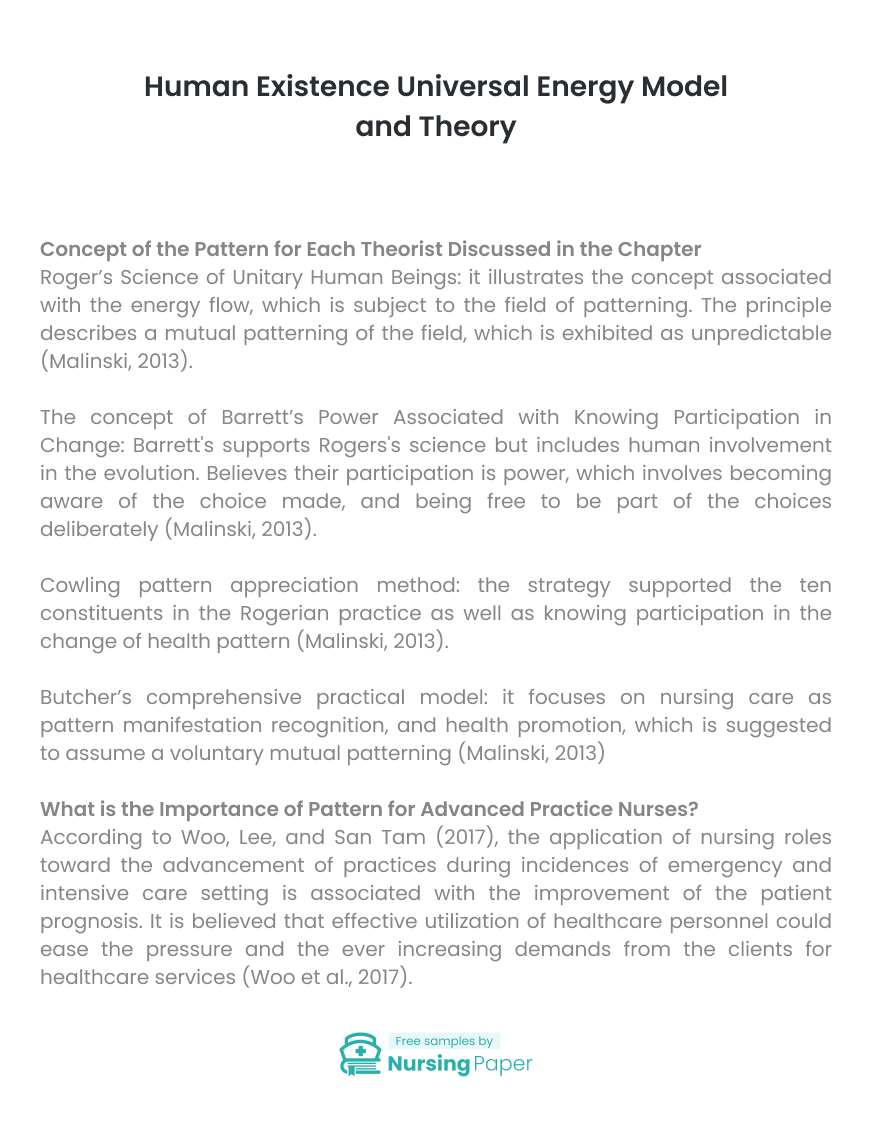
Human Existence Universal Energy Model and Theory
Concept of the Pattern for Each Theorist Discussed in the Chapter
Roger’s Science of Unitary Human Beings: it illustrates the concept associated with the energy flow, which is subject to the field of patterning. The principle describes a mutual patterning of the field, which is exhibited as unpredictable (Malinski, 2013).
The concept of Barrett’s Power Associated with Knowing Participation in Change: Barrett’s supports Rogers’s science but includes human involvement in the evolution. Believes their participation is power, which involves becoming aware of the choice made, and being free to be part of the choices deliberately (Malinski, 2013).


Cowling pattern appreciation method: the strategy supported the ten constituents in the Rogerian practice as well as knowing participation in the change of health pattern (Malinski, 2013).
Butcher’s comprehensive practical model: it focuses on nursing care as pattern manifestation recognition, and health promotion, which is suggested to assume a voluntary mutual patterning (Malinski, 2013)
What is the Importance of Pattern for Advanced Practice Nurses?
According to Woo, Lee, and San Tam (2017), the application of nursing roles toward the advancement of practices during incidences of emergency and intensive care setting is associated with the improvement of the patient prognosis. It is believed that effective utilization of healthcare personnel could ease the pressure and the ever increasing demands from the clients for healthcare services (Woo et al., 2017).

Applying Advanced Practice Nurses for Rogerian Nursing Science to Enhance Evidence Based Services
Professionals choosing to become nurses invest their time to acquire training and establish a close client relationship to ensure their clients receive quality services (Malinski, 2013). Application of Parse’s idea by nurses includes respecting the dignity of the client, deliver services that are helpful, and participation in the movement that aims to revolutionalize the profession to assume a patient centered approach as previously illustrated by Hutchings (2002).
1. Hutchings, D. (2002). Parallels in practice: Palliative nursing practice and Parse’s theory of human becoming. American Journal of Hospice and Palliative Medicine, 19(6), 408-414.
2. Malinski, V. (2013). Models and theories focused on human existence and universal energy. In Philosophies and theories for advanced nursing practice (pp. 446-480). Jones & Bartlett Learning, Ontario, Canada.
3. Malinski, V. M. (2006). Rogerian science-based nursing theories. Nursing Science Quarterly, 19(1), 7-12.
4. Woo, B. F. Y., Lee, J. X. Y., & San Tam, W. W. (2017). The impact of the advanced practice nursing role on quality of care, clinical outcomes, patient satisfaction, and cost in the emergency and critical care settings: a systematic review. Human Resources for Health, 15(1), 63.



The download will start shortly.

The download will start shortly.
 Subject:
Medicine
Subject:
Medicine  Number of pages: 5
Number of pages: 5  Subject:
Health and Social Care
Subject:
Health and Social Care  Number of pages: 2
Number of pages: 2  Subject:
Health and Social Care
Subject:
Health and Social Care  Number of pages: 6
Number of pages: 6  Subject:
Medicine
Subject:
Medicine  Number of pages: 13
Number of pages: 13  Subject:
Nursing
Subject:
Nursing  Number of pages: 5
Number of pages: 5  Subject:
Health and Social Care
Subject:
Health and Social Care  Number of pages: 3
Number of pages: 3  Subject:
Nursing
Subject:
Nursing  Number of pages: 4
Number of pages: 4  Subject:
Health and Social Care
Subject:
Health and Social Care  Number of pages: 4
Number of pages: 4  Subject:
Nursing
Subject:
Nursing  Number of pages: 5
Number of pages: 5  Subject:
Health and Social Care
Subject:
Health and Social Care  Number of pages: 4
Number of pages: 4  Subject:
Nursing
Subject:
Nursing  Number of pages: 2
Number of pages: 2  Subject:
Nursing
Subject:
Nursing  Number of pages: 6
Number of pages: 6  Subject:
Health and Social Care
Subject:
Health and Social Care  Number of pages: 299
Number of pages: 299  Subject:
Nursing
Subject:
Nursing  Number of pages: 5
Number of pages: 5  Subject:
Nursing
Subject:
Nursing  Number of pages: 6
Number of pages: 6 
